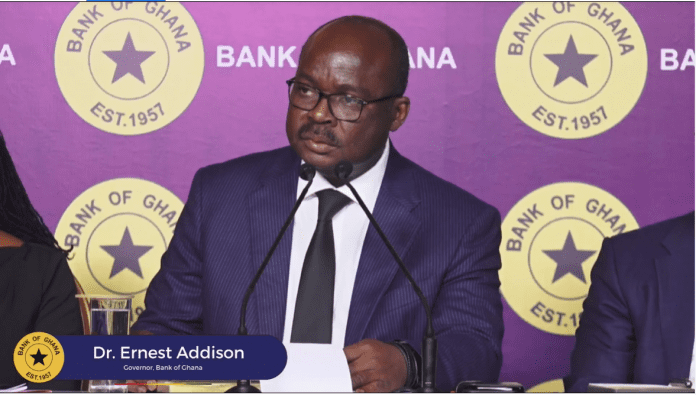The Governor of the Bank of Ghana (BoG) Dr Ernest Addison has explained what led to the central bank losing $3.6 billion in reserves.
Addressing the 110th Monetary Policy Committee (MPC) press conference in Accra on Monday, January 30, he explained that last year, the government was unable to go to the international capital market to raise funds.
But at the same time, the government needed to service its debts and pay for crude oil and other payments.
The funds that were used in making those payments, he said, were taken from the BoG’s reserves, leading to the loss of $3.6billion.
Dr Addison expressed optimism that the International Monetary Fund (IMF) will approve Ghana’s agreement and start making disbursements by end of the first quarter of this year to shore up the reserves.
He said “We have gone very far with the staff-level agreement [with the IMF]. We hopefully should be seeing the end of the Domestic Debt Exchange. We are also making progress on the external side of the external debt restructuring, the necessary committees have all been formed. we are confident that by the end of the first quarter, we should be able to get the disbursements from the IMF to help augment the foreign exchange resources of the central bank.
“The reason why the government had to announce a debt standstill is that we needed to conserve the foreign exchange that we had. A lot of people do not recognize that even though we were not able to go to the capital market in 2022, we continued to service our debts, we continued to pay for oil, we continued to do other payments. Where did we get those resources from? It came from the reserves of the central bank, that is why we lost 3.6bn dollars in reserves.”
Dr Addison further stated that, going forward, measures have to be instituted to strengthen a stabilize the BoG reserve.
“What the debt standstill does is to sort of plug that leak, therefore going forward we do not expect to be losing reserves because of those types of payments at the rate at which we were losing reserves earlier.
“That also means that we should ensure that the central bank reserves is strengthed and stabilized over the next quarter or so, and then after the next quarter if these disbursements come through we should be able to start building reserves,” he said.
On the issue of inflation, Dr Ernest Addison said that the central bank is targeting to bring down inflation to a single digit, 8 per cent.
This is a target over the next four to five years, he added.
Ghana’s inflation rate stands at 54.1% as of December last year.
He said “we try as much as possible to take policy decisions that will help bring inflation down. In that context, the direction of inflation is not only going to be determined by policy rate but a whole lot of other factors including the macroeconomic framework which we have described.
“If you look at the time frame we are looking at three to four years time frame, that is what the IMF programme is designed to do. Within that time we expect to bring down to the Bank of Ghana single-digit target, plus or minute 2 percent, around the central point of 8 percent. This is really the objective of Monetary Policy over the next four to five years.”
He also announced that the MPC has increased the policy rate to 28 percent.
This is up from the earlier rate of 27%.
This was announced by the governor of the BoG at the 110th MPC Press conference in Accra on Monday, January 30.
The upward adjustment reflects the increasing rate of inflation which hit a record high of 54.1% in December last year.
“In the interim, the MPC sees the need to remain vigilant and moderate liquidity in the system to underpin macroeconomic adjustments taking place to drive inflation on a downward path.
“Under the circumstances, the Committee decided to increase the policy rate by 100 basis points to 28%”, the MPC chaired by the Governor of the Bank of Ghana, Dr. Ernest Addison revealed.
By Laud Nartey|3news.com|Ghana


